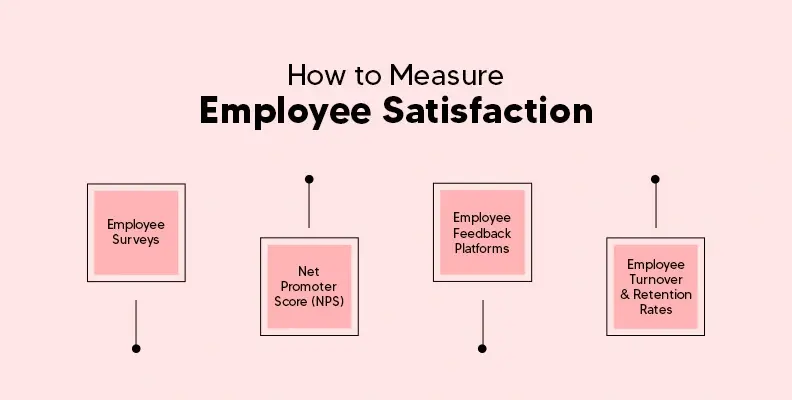Loading.....
Measuring and Improving Employee Satisfaction: HR Metrics

Understanding and improving employee satisfaction in the dynamic field of human resources has become essential to the success of every organization. Happy Employees are a driving force behind more output, more innovative thinking, and higher employee retention than they are merely a nice byproduct of a healthy workplace.
As HR professionals, one of our key responsibilities is to measure and continually improve employee satisfaction. In this blog post, we delve into HR metrics, exploring how they can be leveraged to gauge and enhance employee satisfaction.
What is Employee Satisfaction?
The sincere connection between a person and their workplace is known as employee satisfaction. It represents a deep sense of fulfilment, companionship, and purpose that goes beyond simple contentment.
Importance of Employee Satisfaction
Employee satisfaction is more than just a feel-good factor; it's a critical component of a healthy and productive work environment. Satisfied employees are likely to be more engaged, committed, and loyal to the organization. They tend to exhibit higher levels of productivity and are less likely to seek opportunities elsewhere. Moreover, a positive work atmosphere contributes to a company's employer brand, making it an attractive place for top talent.

How to Measure Employee Satisfaction
Employee satisfaction is no doubt a critical factor in the success of any organization. Happy and engaged employees contribute to a positive work environment, increased productivity, and overall business growth. However, measuring employee satisfaction is not a one-size-fits-all endeavour.
Here are some popular methods and strategies to effectively measure employee satisfaction:

- Employee Surveys: One of the most common and effective ways to measure employee satisfaction is through surveys. These surveys can be conducted annually, quarterly, or even monthly, depending on the organization's needs. The key is to design thoughtful and comprehensive surveys that cover various aspects of the employee experience, such as job satisfaction, work-life balance, communication, and career development. To maximize the effectiveness of surveys, ensure anonymity to encourage honest feedback. Utilize a mix of open-ended and closed-ended questions to gather both quantitative and qualitative data. Analyzing survey results can provide valuable insights into areas that need improvement and those where the organization excels.
- Net Promoter Score (NPS): Originally used to measure customer satisfaction, the Net Promoter Score (NPS) has found its way into the realm of employee satisfaction measurement. Employees are asked a simple question: "On a scale of 0 to 10, how likely are you to recommend this organization as a place to work?" Those who respond with 9 or 10 are considered promoters, 7 or 8 are passive, and 0 to 6 are detractors.
- Employee Feedback Platforms: Leveraging technology, organizations can utilize employee feedback platforms to gather real-time feedback on various aspects of the workplace. These platforms often feature pulse surveys, continuous feedback channels, and sentiment analysis tools. By collecting feedback more frequently, organizations can address issues promptly and make quick adjustments to enhance employee satisfaction.
- Employee Turnover and Retention Rates: High turnover rates can be indicative of dissatisfaction among employees. Monitoring turnover and retention rates over time provides valuable insights into the health of the organization's workforce. A sudden spike in turnover may signal underlying issues that need attention, such as poor management, lack of career development opportunities, or an unhealthy work environment.
Calculating the NPS involves subtracting the percentage of detractors from the percentage of promoters. A positive NPS indicates a favorable employee satisfaction level. Regularly monitoring the NPS allows organizations to track improvements or declines in employee satisfaction over time.
Implementing employee feedback platforms also demonstrates a commitment to transparent communication and employee well-being. It fosters a culture where employees feel heard and valued, contributing positively to overall job satisfaction.
Strategies for Improvement Employee Satisfaction

- Act on Survey Feedback: Employee surveys are only valuable if organizations act on the feedback received. Use the survey results to identify specific areas of concern and implement targeted initiatives for improvement.
- Promote Work-Life Balance: Encourage and support initiatives that promote a healthy work-life balance. This could include flexible work arrangements, remote work options, or wellness programs.
- Recognition and Rewards Programs: Acknowledging and rewarding employees for their contributions can significantly impact job satisfaction. Implement recognition programs that highlight and celebrate achievements.
- Professional Development Opportunities: Employees are more satisfied when they see a clear path for professional growth. Invest in training and development programs that empower employees to enhance their skills and advance in their careers.
- Open Communication Channels: Establish open lines of communication between management and employees. Regularly communicate organizational goals, changes, and updates to foster transparency and trust.
Conclusion
Measuring and improving employee satisfaction is an ongoing process that requires a strategic and proactive approach. By leveraging HR metrics, organizations can gain valuable insights into the factors influencing employee satisfaction and take targeted actions to create a workplace where employees not only thrive but also contribute to the overall success of the organization.
After all, a satisfied workforce is not just a metric to track; it's a strategic advantage in today's competitive business landscape.
 Back to blog
Back to blog












